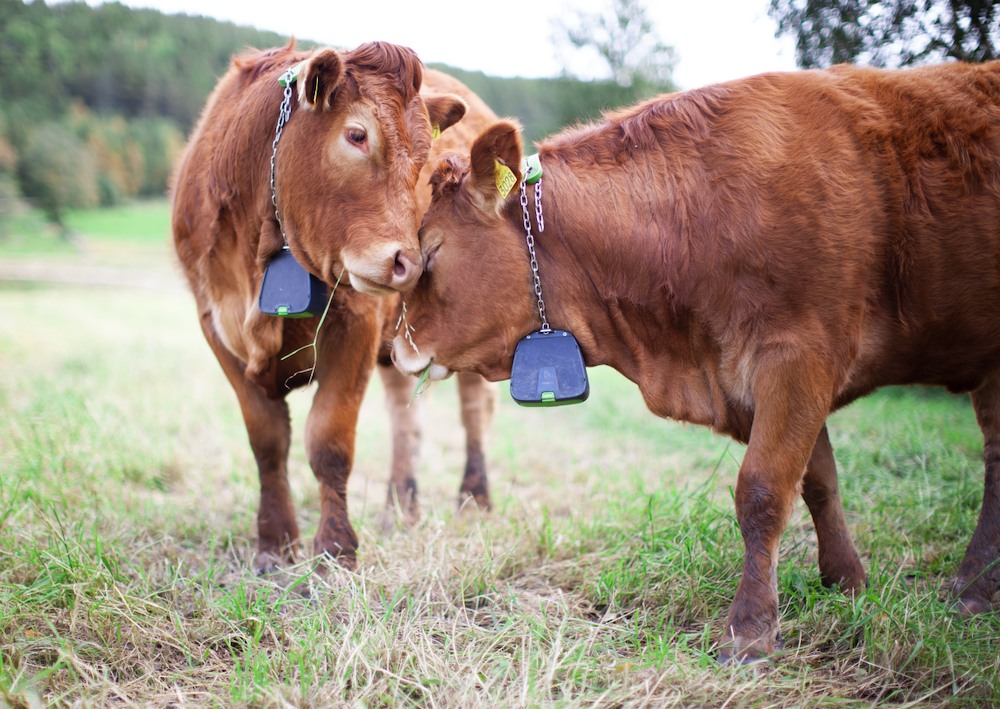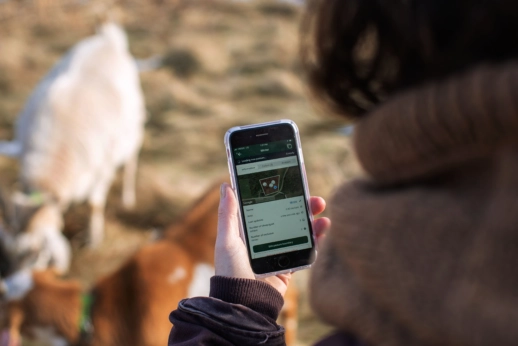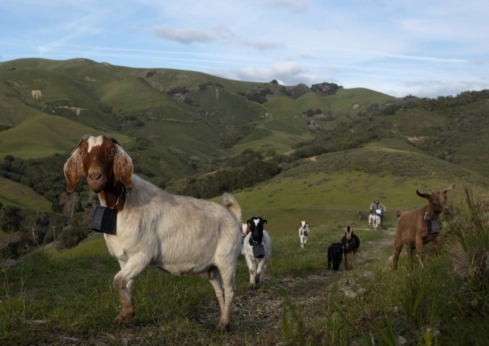Virtual fencing is being introduced to ranchers across the United States. Here's how it’s affected their livestock operations.

Today, more than 620,000 miles of fence branch across the western United States. That’s equal to a trip to the moon and back—and halfway there again. Maintaining and building fences is a yearly job on every ranch, costing at least $20,000 per mile. Once these fence posts are hammered into the ground, ranchers battle trees, wind and damage from livestock knocking them over. Many ranchers are realizing that physical fences may not be the future of ranchland management.
Now ranchers around the country are trialing a new technology, virtual fencing, to manage animals and their land. A Norwegian company called Nofence is one of the first companies making this fence available to ranchers in the United States. There are several other systems also piloting their products, including Vence, eShepherd and Corral Technologies.
Virtual fencing supplies ranchers with a collar solar or battery charged and uses a web-based app to remotely monitor and control where livestock graze. The rancher can use a smartphone, tablet or computer to draw paddock boundaries, and the collars are equipped with GPS to track the animals’ movements throughout the day. If an animal approaches the boundary, they receive an auditory warning that intensifies as they get closer. When the animal crosses the boundary, it receives an electric pulse that is less intense than that of an electric fence.
The technology was designed to improve environmental and economic outcomes for livestock operations, while also reducing labor costs for ranchers and maintaining animal welfare. For those trialing virtual fencing products across the country, it’s achieved more.
“I think it’s the future and there’s a ton of potential,” says Aaron Steele, founder and co-owner of mobile grazing company Goats on the Go. “To be able to do things like graze a small hilltop for four hours and not eliminate all of the vegetative cover, it opens up an opportunity we never had before.”
Environmental benefits
Regenerative grazing—or closely managing where and for how long animals forage—is a farming practice that can improve soil health and plant diversity. Ranchers think virtual fencing helps them be more efficient. Each new boundary drawn by a rancher moves livestock onto a fresh paddock, allowing grazed pastures time to recover as livestock feed in a new location.
“We can move the goats an unlimited number of times a day if we want to,” says Adam Ledvina, owner of Iowa Kiko Goats and Blue Collar Goatscaping. “In a better world, you move your animals every day. And the more often you can move them, the better you are.”
For conservationists, it may also help a declining habitat. The United States has lost more than 50 million acres of grasslands in the last 10 years, and groups such as The Nature Conservancy and their partners are trialing virtual fences as a tool for conservation and grazing operations.
Grasslands need stimuli from grazing to encourage plant growth and recycle nutrients into the soil, but the ecosystem also needs time to recover to decrease soil erosion. Virtual fencing enables land managers to be precise and adaptive in their livestock grazing activities so native plants thrive in pastures.
“That’s one of the definite benefits to the soil, having animals on the land,” says Scott Haase, a farmer from Minnesota. “The livestock impact is what most fields have been lacking for the last 75 years.”

Megan Filbert, an adoption program manager at Nofence, uses the Nofence app with her herd of Kiko goats. The white icons represent each collared animal within the virtual boundary. (Photo credit: Robb Klassen)
Animal benefits
Physical fences require ranchers to make frequent trips to their fields to check on their livestock and the stability of the fences. The mobile app connected to the virtual fence collars distributes real-time data on the rancher’s herd, providing information on animal health and location. The collar technology makes it so ranchers can see the current status of the animals anywhere and anytime—as long as there is an internet connection.
“It could be the first thing you do in the morning and the last thing you do at night to make sure all the animals are doing their job and everyone is healthy,” says Ledvina.
Virtual fencing also allows livestock to live more stress free with less human interaction. When animals are exposed to frequent stressors, it can cause an increased susceptibility to disease, decreased feed intake and reduced fertility.
In addition, the technology has even helped save animals’ lives by letting ranchers know when an animal stops moving or a signal is lost.
“I have already saved animals from death because of the data being transmitted from the collars,” says Steele. “Farmers have a much better idea of the current well-being of their animals at any time of day than they’ve ever had before.”
Steele recalls an incident that happened with another rancher participating in the Nofence pilot project with him.
“He was just reviewing the data and found that one of his goats’ activity levels had declined,” says Steele. “He went and caught that goat, and sure enough, it had an injury. He only caught it in time to treat it because of the data.”
Rancher benefits
Virtual fencing has helped farmers monitor the status of their animals through a tap of an app, which current users of this technology says offers peace of mind.
“If there’s a storm and a branch knocks down your fence, you wouldn’t know for a couple days, and this lets you know instantly,” says Ledvina.
In the past, ranchers have struggled to keep livestock out of certain locations, such as bodies of water. Now, ranchers can create unique boundaries for their difficult terrain and even prevent animals from entering areas prone to flooding and wildfires.
The fencing also eliminates hours of intensive labor. Building and maintaining physical fences requires a lot of work, including digging fence posts, replacing damaged fencing after storms and driving across pastureland to install more fencing. Ranchers report labor to be their largest expense, and virtual fencing can eliminate some of this labor.
“I’ve got ponds and terrain to deal with, fallen trees in the wrong place, and all of those things add up,” says Daniel Faidley, operator of a cattle and goat farm in Iowa. “I don’t have piles of time.”

Goats graze hard-to-fence terrain in Southern California. Ryan and Rianna Malherbe own this herd, and they utilize their goats for targeted grazing and wildfire mitigation. (Photo credit: Robb Klassen)
Room for improvement
Despite the suggested benefits the technology has brought to ranchers trialing virtual fencing, there are still some challenges in making it accessible to mass audiences.
Some landowners claim virtual fencing is cheaper than investing in physical fencing, but the cost is still higher than they’d like. The individual cow collars by Nofence cost $329 each and $229 for goats or sheep, but that isn’t the rancher’s only expense. They also have to pay a monthly subscription fee that will vary depending on the size of their herd and other factors. Despite the costs, Ledvina says he believes the reduction of labor costs makes it less expensive and, therefore, worth the investment.
The battery life of the collars is another potential concern. After their initial charge using electricity, some of these collars are charged using solar power, which means that the amount of sun they receive can affect the battery life. In the summer, animals like to seek refuge in the shade. And in the winter, there are fewer daylight hours. Steele says that, although the collars hold their charge for a long time, it can be difficult to get sunlight on these collars at all times.
Another reason some ranchers are hesitant to try virtual fencing is a reluctance to rely too much on technology.
“Some people like to think you’re just getting more into your phone, and I get it, I want to disconnect, too,” says Ledvina. “But I wake up every morning and I’m able to check my animals. I do it to check my livelihood.”
A look into the future
Many ranchers consider virtual fencing to be the next frontier. It’s made it easier for farmers to do things they haven’t been able to do before and gives them time to prioritize what they’ve been missing out on.
With the trial’s success, Nofence is currently considering how many collars will be available to the public for 2024, with a priority going to sheep and goat collars. Its cattle collars are expected to launch in 2025. eShepherd, produced by Gallagher Animal Management, will also be available to the public some time this year.
For those still debating trying out virtual fencing technology, Haase says it’s worth taking a chance.
“I think once it really takes off, people are going to do creative and surprising things with it,” says Haase.
Jenny Melo Velasco and Kelly Wilson contributed reporting to this story.
Want to get in line for access to virtual fencing technologies? Farmers and interested readers can register interest or sign up on a waitlist to be the first to receive these collars. Here are links to the major companies on the market:
To learn more about The Nature Conservancy and partners’ projects to research how virtual fencing can help managers improve soil carbon storage, biodiversity and economic outcomes, you can read more about it here.

I don’t see this working on the cattle that I dealt with for 40 years. When they are motivated they even go thru 4 strand bob wahr. What is the transmit range? Where I lived there were 10;000 acres of range, with canyons and bowls. No cell phone coverage for most of it.
Too bad the article didn’t mention “Moovement cattle ear tags” which is the most economical, practical and proven LORA based GPS solar ear tag system. Trumps the reliability, simplicity, practicality and duration of use without the need to recharge or replace collars every 2-3 months despite not having a deterrent shock or buzz. I know because I’m a very satisfied user who has been following this technology for years.
I have 20,000 cattle, cannot see at the moment the cost of this,,,
I find this quite interesting and effective.
Thanks for sharing this very well-written and worth-reading article. Wish to see more in the coming days.